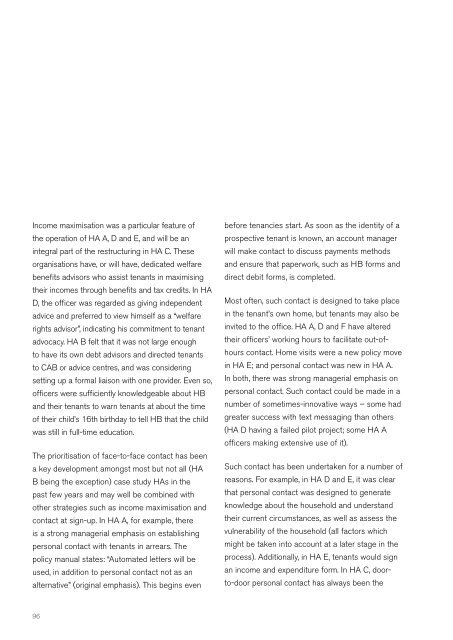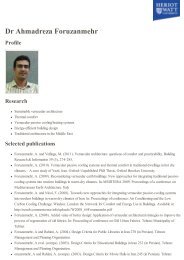Rent arrears management practices in the housing association sector
Rent arrears management practices in the housing association sector
Rent arrears management practices in the housing association sector
You also want an ePaper? Increase the reach of your titles
YUMPU automatically turns print PDFs into web optimized ePapers that Google loves.
Income maximisation was a particular feature of<br />
<strong>the</strong> operation of HA A, D and E, and will be an<br />
<strong>in</strong>tegral part of <strong>the</strong> restructur<strong>in</strong>g <strong>in</strong> HA C . These<br />
organisations have, or will have, dedicated welfare<br />
benefits advisors who assist tenants <strong>in</strong> maximis<strong>in</strong>g<br />
<strong>the</strong>ir <strong>in</strong>comes through benefits and tax credits . In HA<br />
D, <strong>the</strong> officer was regarded as giv<strong>in</strong>g <strong>in</strong>dependent<br />
advice and preferred to view himself as a “welfare<br />
rights advisor”, <strong>in</strong>dicat<strong>in</strong>g his commitment to tenant<br />
advocacy . HA B felt that it was not large enough<br />
to have its own debt advisors and directed tenants<br />
to CAB or advice centres, and was consider<strong>in</strong>g<br />
sett<strong>in</strong>g up a formal liaison with one provider . Even so,<br />
officers were sufficiently knowledgeable about HB<br />
and <strong>the</strong>ir tenants to warn tenants at about <strong>the</strong> time<br />
of <strong>the</strong>ir child’s 16th birthday to tell HB that <strong>the</strong> child<br />
was still <strong>in</strong> full-time education .<br />
The prioritisation of face-to-face contact has been<br />
a key development amongst most but not all (HA<br />
B be<strong>in</strong>g <strong>the</strong> exception) case study HAs <strong>in</strong> <strong>the</strong><br />
past few years and may well be comb<strong>in</strong>ed with<br />
o<strong>the</strong>r strategies such as <strong>in</strong>come maximisation and<br />
contact at sign-up . In HA A, for example, <strong>the</strong>re<br />
is a strong managerial emphasis on establish<strong>in</strong>g<br />
personal contact with tenants <strong>in</strong> <strong>arrears</strong> . The<br />
policy manual states: “Automated letters will be<br />
used, <strong>in</strong> addition to personal contact not as an<br />
alternative” (orig<strong>in</strong>al emphasis) . This beg<strong>in</strong>s even<br />
96<br />
before tenancies start . As soon as <strong>the</strong> identity of a<br />
prospective tenant is known, an account manager<br />
will make contact to discuss payments methods<br />
and ensure that paperwork, such as HB forms and<br />
direct debit forms, is completed .<br />
Most often, such contact is designed to take place<br />
<strong>in</strong> <strong>the</strong> tenant’s own home, but tenants may also be<br />
<strong>in</strong>vited to <strong>the</strong> office . HA A, D and F have altered<br />
<strong>the</strong>ir officers’ work<strong>in</strong>g hours to facilitate out-ofhours<br />
contact . Home visits were a new policy move<br />
<strong>in</strong> HA E; and personal contact was new <strong>in</strong> HA A .<br />
In both, <strong>the</strong>re was strong managerial emphasis on<br />
personal contact . Such contact could be made <strong>in</strong> a<br />
number of sometimes-<strong>in</strong>novative ways – some had<br />
greater success with text messag<strong>in</strong>g than o<strong>the</strong>rs<br />
(HA D hav<strong>in</strong>g a failed pilot project; some HA A<br />
officers mak<strong>in</strong>g extensive use of it) .<br />
Such contact has been undertaken for a number of<br />
reasons . For example, <strong>in</strong> HA D and E, it was clear<br />
that personal contact was designed to generate<br />
knowledge about <strong>the</strong> household and understand<br />
<strong>the</strong>ir current circumstances, as well as assess <strong>the</strong><br />
vulnerability of <strong>the</strong> household (all factors which<br />
might be taken <strong>in</strong>to account at a later stage <strong>in</strong> <strong>the</strong><br />
process) . Additionally, <strong>in</strong> HA E, tenants would sign<br />
an <strong>in</strong>come and expenditure form . In HA C, doorto-door<br />
personal contact has always been <strong>the</strong>




